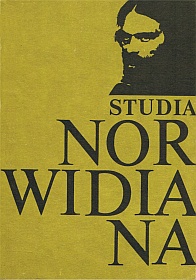Vade-mecum As an Editorial Problem
Abstract
The paper presents the most important problems encountered by the publisher and the reader of the poetical cycle Vade-mecum by Cyprian Norwid.
Part 1 of the paper gives an outline of Vade-mecum’s publishing history starting from the first edition of the work published in Brockhaus’ Publishing House, through the fragmentary publications of Zenon Przesmycki (Miriam), the “discoverer” of Norwid, until the publishing of Norwid’s autography in 1947 made by Waclaw Borowy. This latter edition especially, starts a period of increasing interest in the cycle evidenced among other things by the numerous editions of the work also in other languages.
And yet the text of Vade-mecum has not been fully interpreted and duly published in spite of the great amount of work done in this field by Juliusz Wiktor Gomulicki, the main contemporary editor of Norwid’s poetry.
Part 2 presents still unsolved problems or those whose explanations are unsatisfactory or altogether wrong.
- Vade-mecum was intended by Norwid to constitute one of the three parts of volume 2 of his Poezje. Apart from Vade-mecum volume 2 was to have included two dramas: Tyrtej and Aktor (The Actor), however, such a composition of the edition has not been published so far. Thus, in this case, the author’s intention has not been fulfilled.
2. Vade-mecum has been traditionally treated as a uniform piece of poetry or as some artistic wholeness. This is a simplification since the lyrical cycle suffered some partial destruction resulting from different and not always known to us, events. From the one hundred lines marked from 1 to 100 by the author only 78 have remained until Przesmycki’s time and today. 14 lines have been lost altogether and futher 8 survived only in fragments. Thus, Vade-mecum could never be called a wholeness in the future.
3. The publishing practice of publishing single or a few texts of the collection separately seems to require distinct notice given by the publishers which would attach the texts to Vade-mecum. The obliteration of these attachments runs counter the intention of the author and deprives a non-professional reader of important contextual information.
4. There are significant difficulties in unquestionable determination of the time when Vade-mecum cycle was written. It is a well known fact that Norwid, when preparing volume 2 of Poezje, selected lyrical poems written before. During his work on volume 2, which lasted from summer 1865 to march 1866, he elaborated anew many of his old texts. Beside that, after his negotiations with Brockhaus’ Publishing House had broken off, the poet returned to this lyrical cycle on several occasions revising the texts and even eliminating some of them. The above explains why the determination of the texts’ chronology is difficult so that modem settlements in this respect are still hypothetical.
5. Also hypothetical is the determination of the time when the idea to compose the cycle appeared. A cautious calculation points only to some limits of time: between 1855 and 1865.
Part 3 discusses detailed editorial problems.
- In the face of the fact that Norwid corrected and revised the autography of Vade-mecum the editor has to choose between different versions of the text to submit only one for publication. And this is often an insoluble dilemma. The author’s corrections are various and variform, which facilitates extracting the original text prepared for Brockhaus from other versions of Vade-mecum. Not all corrections, however, are legible and not all interpretations are convincing; it is postulated that a most faithful copy of the original autography possible should be published (in colour necessarily in the case of some fragments at least) so as to help philologists work on the still not deciphered or dubiously interpreted lines corrected by Norwid. The present paper presents examplary analyses of so-far settlements which raise doubt.
2. With regard to Norwid’s handwriting and orthography much remains to be studied thoroughly. In the paper the author points out to numerous graphic and orthographic inconsistencies which make proper edition of Vade-mecum extremely difficult as well as lead to arbitrary solutions.
3. Norwid’s punctuation belongs to the most difficult areas as regards editing. In this aspect, Vade-mecum is characterized by great unconventionality and variform functions of punctuation. This is one of the reasons for which contemporary editions are arbitrary and hypothetical. Norwid used punctuation and other graphic signs to signal special semantic function of a word or sentence and to clothe the poem in a specific “intonational score”. In his linguistic style there cross at least two tendencies: properties of the punctuation based on syntactic-logical segmentation and the properties of Old Polish tradition which bases punctuation on intonational-rhetori- cal principles.
4. The author comments upon the graphic composition of the poems in Vade-mecum. He demands that Norwid, as a talented graphic artist, should not be “corrected”, or when he is, this should be done with greater piety. Unfortunately, Vade-mecum has not been protected from editorial “corrections” also in this field.
The author’s conclusion is that further collective work of Polish philologists is necessary to obtain possibly complete shape of Norwid’s poem.
Copyright (c) 1984 Studia Norwidiana

This work is licensed under a Creative Commons Attribution-NonCommercial-NoDerivatives 4.0 International License.





